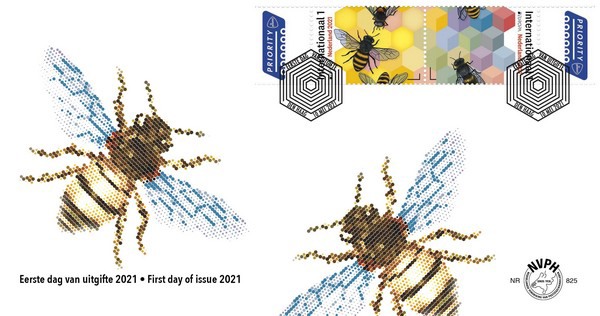PostNL is putting the Dutch wild bee in the spotlight with a new series of stamps. For the two international stamps, the Nederlandse Vereniging van Postzegelhandelaren (NVPH) designed a first-day envelope. The stamps and first-day envelope will be released on May 10, 2021.
The Dutch bee population is dangerously thinning, municipalities are intervening, says the stamp association in press release. Of the 358 bee species living in the Netherlands, half are endangered. Causes are a lack of nesting opportunities and food. This despite the fact the wild bee is crucial for the production of our food.

National bee count
On 17 and 18 April, the fourth national bee count was organised. More than 9,000 people counted 168,000 bees, almost 40,000 more than last year, when counted by 10,000 pairs of eyes. Despite the rising numbers, the threat to many bee species is worrying.
Humans are dependent on the bee for our food supply, and many flowers, plants and animals are equally dependent on the bee. The honey bee is the most commonly observed, the earth bumble bee is in third place. The red mason bee is steadily in second place.
Bee-rich city gardens
In the cities, more and more attention is being paid to the bee. Many municipalities and garden owners now pay more attention to a natural environment for the bee and more hobby beekeepers have come to town. More greenery and honey-rich flowers, fewer tiles and more bee hotels also contribute to an attractive green environment. Municipalities have improved their mowing policies, and lawns are being raked over for wildflower beds.
Independent queen
Bees and bumblebees collect pollen and turn it into honey. Bumblebees have no honey supply and no honeycomb. They store a little nectar for themselves. Honey bees build honeycombs as a swarm and the 'workers' take care of the queen. The bumblebee queen does all this without help. Bumblebees and honeybees are very recognisable, solitary bees have a very diverse appearance and different ways of life. They nest in the ground, in the sand or in hollow stems. The wild bee is a lover of the bee hotel.
The first-day envelope
In the past, envelopes without stamps were sold separately in stamp shops. Collectors franked them and sent them (in an envelope) to the PTT, to be stamped on the day of issue. After 1960 more and more collectors started to collect the envelopes 'blanco' (without an address). Older first-day envelopes without an address are scarce and an interesting investment. The NVPH annually designs annually around twenty first day envelopes matching the stamp series. First-day envelopes with buildings and animals are a popular collector's item.
For more information:
N.V.P.H.
www.nvph.nl
info@nvph.nl
